- Products

Enjoy a free 30-day trial of our
data validation software.Experience the power of trusted data
solutions today, no credit card required! - Solutions

Enjoy a free 30-day trial of our
data validation software.Experience the power of trusted data
solutions today, no credit card required! - Partners

Enjoy a free 30-day trial of our
data validation software.Experience the power of trusted data
solutions today, no credit card required! - Learn more
- Pricing
- Contact Us
A simplified approach to building your data management program
Data is at the heart of your business, and it powers everything you do. In our most recent research study, we found that 97 percent of organizations globally use data to power business opportunities. That said, data tends to live within departmental silos, and the responsibility for the data strategy often falls to the IT department. Yet, we know that building a data management program is a complex process that requires a collaborative effort from across the organization.
Businesses that have been most successful are the ones that simplify their data management process into terms everyone in the organization can understand. After all, data should be accessible to both IT and business users, right? So speaking about your data program using a common language will help everyone understand the strategy.
Building a data management program is a lot like building a house. It takes time and requires a methodical approach—and it really does take a team. But, if you’re successful, your data management program can be done at scale. So if you’re about to tackle a data management project, break it down into three straightforward steps that everyone (even the basic homeowner) can understand: analyze, improve, and control (Figure 1).
Analyze: Assess the land and build your foundation
Any homeowner can tell you that building a sturdy house starts with the foundation, so getting this step right is critical. Before you can begin pouring cement, you’ll need to assess the plot of land. You’ll likely need to bring in a surveyor to measure the grade and slope of the land, which will help to inform the overall design and any leveling that needs to happen. You’ll also want to bring in a specialist to test the soil for contaminants and to identify any additional environmental factors that could cause an issue down the line. Once you’ve finished surveying the land, you’ll want to work with an architect to plan out the schematics for your house. Blueprints in hand, you’re ready to start pouring the foundation.
The same concept can be applied to building a data management program. Before you start creating governance policies and investing in data management tools, it’s necessary for the project owner (typically the chief data officer or chief information officer) to define what data quality actually means for the organization. For instance, is quality based on the completeness of records or is it the number of null values? By taking this time to define what quality means to your organization, you’ll be able to align the rest of your strategy to it.
Next, you’ll want to bring in the surveyors to assess your current data landscape. In this case, that’s your IT department. The IT team should conduct a full-volume analysis of your data sets in order to help with profiling and discovery. Rather than looking at a small sample of your data, full-volume discovery methods enable you to analyze every part of your database at once. While sampling is often seen as a faster method of discovery, the right tools can perform full-volume analysis with impressive speed.
More often than not, there’s a greater variety of information in your database than you realize, so running a full-volume analysis can tell you exactly what you’re dealing with and what could be a potential issue down the road. Working with your data architect, you can begin to plan a blueprint for your data management program based on the results of your discovery activities.
Improve: Construct the framework and run the utilities
With a solid foundation established, the next step in home building is to assemble the framework of the house, which requires constant collaboration between the contractor, the architect, and the builders. As the architect’s plans are carried out by the builders and the structure begins to take shape, you’ll start to make decisions about the interior flow of the house. Are you building a split-level home or a single-level ranch? Do you want an open-concept layout, or do you prefer separate spaces for cooking and entertaining? The layout you choose will affect the materials and costs down the road. At this point, you’ll also need to run the utilities (like electrical, HVAC, and plumbing) throughout the frame.
When it comes to your data management program, this is the point at which you transition from planning to doing. Use the blueprints you’ve made with the data architect to guide the project as you work with your IT department to implement the data management architecture. As you begin to define the rules and processes for how data will flow through your systems, you’ll likely need to make decisions around cleansing, standardizing, and enriching the data.
A common finding of a full-volume analysis is a lack of standard data formats. In this case, you might find the word "Street" spelled out in some instances or abbreviated "St" elsewhere. Likewise, state names can be spelled out, abbreviated, or truncated (like "Mass" or "Calif"). And this is just the tip of the iceberg! Your data management program will need to have rules in place to cleanse and standardize the existing data and to ensure that new data coming into the system conforms to these rules.
Of course, any rules that transform the data should be vetted by the business users first. Think of your business’s data stewards as the plumbers in this scenario. You wouldn’t move the location of the bathroom without consulting the plumber to see if it’s feasible first, would you? Of course not. As you begin to transform your data, securing feedback from the business users who understand that data is critical. Otherwise, you could end up creating a data management strategy that is as useful as a bathtub in the kitchen.

Another area that you would want to consider has to do with enriching your data. This means either integrating disparate data sources you already have to make them more useful, or purchasing third-party data that can provide deeper insight into the records you already have. For instance, if your business collects the names, addresses, and postal codes of your customers, you can append an array of demographic, lifestyle, and socioeconomic information that would help you make smarter marketing decisions. Are you sending mailers to recent college grads or baby boomers? Data enrichment can help you figure that out.
Control: Add the finishing touches
Now that the frame of the house is assembled and the utilities have been installed, it’s time to start finishing the project so that it can be monetized. This includes bringing in carpenters and other specialists to put up the drywall, kitchen cabinetry, windows, and other final details that make your house habitable.
While the crew of specialists is working on the finer details, the contractor is overseeing the progress (and quality of work) to ensure that the project remains on schedule and budget. At this time, you should also be installing smoke and carbon monoxide detectors throughout the house to ensure you’re up to code before the necessary city inspections. After all, the inspector can pull the plug on the project or cause massive delays if it’s not done properly.
In terms of your data management strategy, you have the rules and processes in place to be successful. Now, you just need to start using your data as an asset and monetizing it. If you've chosen to enrich your customer contact data, for example, you can start to do things like segmentation, buyers' journeys, and targeting. Even if you've done a basic cleanse of your database, you can take advantage of the confidence that comes with increased accuracy to start making data-driven decisions.
With clear criteria for quality and rules for standardizing the data coming through the system, your business users can begin to build dashboards and define KPIs for the data management program. Much like the ongoing maintenance a homeowner will need to do, your business users will need to keep an eye on your data quality over time. Tools with visual dashboards and automated alerts can make it easier to do things like reporting, tracking, and trending of data.

With greater access to high-quality data, your organization can finally start to monetize this information by increasing productivity, reducing waste, and driving additional revenue. Further, by monitoring your data continuously, you’ll ensure your organization’s data is in compliance the next time regulators come knocking.
Delivering data management at scale
In order for your data management strategy to be successful, it needs to be a fully scalable program for the business. And that means it needs to support the interests of areas of the business beyond the IT department. The challenge is that business users often do not understand their role in data management, as the responsibility typically falls to the IT department. But the increasing demands for data-driven business intelligence mean that business stakeholders will need to take an active role in managing their data.
We believe speaking a common language can help IT and business users minimize some of these challenges and help all areas of the organization understand the data management strategy. By explaining your data management program in three steps—analyze, improve, control—and by making it relatable to something most people can understand, you’ll see improved reception and accountability for data management.

